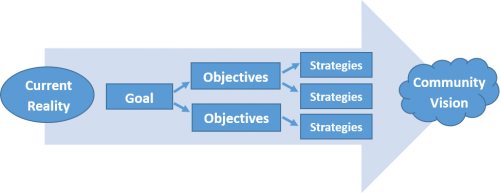Implementing community vision requires detailed strategies
All too often, community master plans include wonderfully crafted visions and goals, but fall short on the detail needed in the form of individual strategies. It is detailed strategies that are most likely to lead to plan implementation.
Visioning is a participatory process where stakeholders and citizens develop a consensus on what a community will look, or be, like in the future. For community planning, this public participation technique often happens at the beginning of a planning process and can involve one or several public meetings. Visioning is a means for participants to express what a desirable future would look like, based on emphasized community values.
There are many ways to conduct a visioning session. Regardless of the approach, there are three general components to the process.
- First, participants must imagine the future. Meeting organizers usually ask a question like, “What are people saying about the community, what do the headlines in the paper read, in five, ten or 20 years?”
- After each participant has developed their own vision of the future, individuals share their vision with others and things each vision has in common are noted.
- Lastly, using the common aspects of the visions, a draft community vision is prepared and refined with subsequent opportunities for participant comments.

Ideally, the resulting vision statement reflects the consensus of the participants in the process. The community vision comprises peoples’ values, wishes, fears and desires and the process has a tendency to produce an idealistic, seemingly intangible view of the future. Therefore, the process should be continued to develop a set of goals, objectives and strategies which move today’s community toward the consensus community vision. The community vision will have individual components that lend themselves to individual goals. For instance, the City of Marquette, Michigan envisions itself as “A premier livable, walkable, winter city.” One component of the vision is to better accommodate pedestrians and cyclists throughout the city. This component of the vision becomes a goal that will need to be further defined with a set of objectives.
By definition, objectives are narrower than goals and are considered to be achievable points of reference that describe what is targeted in order to achieve the associated goal. Almost always an objective should be SMART - that is Specific, Measurable, Attainable, Realistic, and Timely. As a community progresses from today to the future vision, the objectives provide reassurance that the community is on the path to achieving that vision. An example objective from the City of Marquette related to the goal of improved walkability is “Keep [streets] small and well linked.”
For each objective there will be one or a number of strategies. A strategy is a method, procedure, or policy statement of a government’s position that is designed to achieve an objective. Strategies are the actual ways the objective is implemented. An example strategy from Marquette is to “Integrate citywide walkability concepts into [street] redesign or maintenance projects.” Lastly, it is important that there are people, a government department, or an agency that is tied to each strategy and committed to carrying it out.
It is the last two – the objectives and strategies – that are often missing or are incomplete in many master plans. Also, they often lack specifics or include words that fall short of being SMART - Specific, Measurable, Attainable, Realistic, and Timely. A detailed and effective strategy related to walkability would be “The city street department will integrate citywide walkability concepts into street redesign and maintenance projects in the next fiscal year.” Compare that to “Study and implement, if feasible, citywide walkability concepts when appropriate.” Further, there are likely to be several strategies for any one objective – as most projects require a multi-pronged approach. So, for the example above, additional strategies to implement the vision of becoming a walkable city might include adoption of a complete streets ordinance, adoption of form based zoning to define block sizes and façade transparency, dedicated funding to clear sidewalks of snow, and more.
Michigan State University Extension can help local leaders design visioning processes and other public engagement strategies for planning projects in your community.



 Print
Print Email
Email



